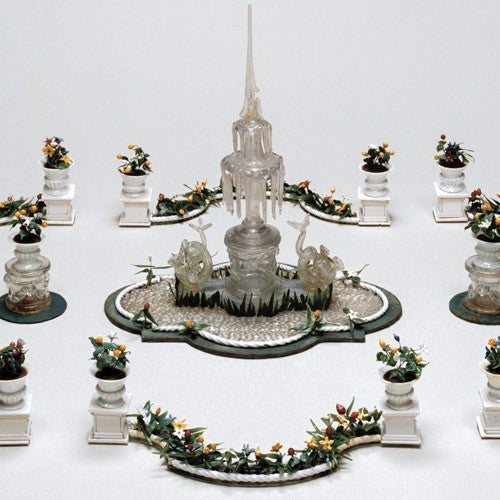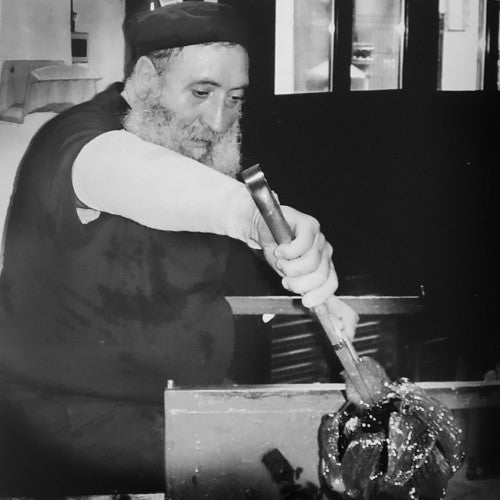Giuseppe Briati (Murano, 1686 - Venice, 1772) was born in Murano from a family that for generations was an expert in glass, and therefore entered in the Golden Book of Murano.
In 1733, Briati moved to Bohemia where he learned the secrets of the crystal. Back in Venice, in 1737, obtained from the Council of X the privilege for ten years to produce crystal works.
As early as 1271, the Venetian government had decreed that the kilns were concentrated in Murano, because of the danger of fire. Briati then opened his business in Murano in 1737. In 1739, however, his furnace was assaulted by Murano glassmakers "at night with firearms" (G. Tassini, Venetian Curiosity , Venice 1872, p. 115) , envious of success of his crystal, very similar to that of Bohemia. Briati found himself thus forced to move its activities in Venice.
A 'Our days however, with new and necessary example, we see a' last time within the City any day those placed our furnaces in the parish dell'Angiolo Rafaello, if not wonderful that celebrated the fine crystal works come from the hands of the valiant Briati, now in formarne chairs, armaj, frames, fruit, flowers, statues, and a thousand other vague ingenious works that have now become the delight of all the cultured nations.
(G. F. Zanetti, Della origine di alcune arti principali appresso i Veneziani, Venice, 1758, p. 83)
In this short piece, Zanetti remembers how to Briati in 1739, by Decree of the Council of X 4 March, it was granted to be able to transfer from Murano to the Carmelite district, on the current foundations Briati (cfr. G. Distefano, Atlante storico della Serenissima (Historical Atlas of the Serenissima), 1600-1797, Vol. 4, Venice 2010, p. 903). The same year, Briati, proving astute trader, he requested and obtained the privilege to buy potassium saltpeter (used to make stronger the glass) at a lower price. In this way, Briati managed to sell his crystal, just as solid and glittering, at a lower price than that of Bohemia. For his commercial success, the Serenissima awarded him, renoving him the exemption from contributions to the social security fund for disabled glassmakers, and at the same time allowing him to overcome the expected number of employees of the furnace.
The Briati glass factory was well known for the production of its chandeliers, inspired by those of Bohemia elegant, but were distinguished by greater attention to the richness of color and the use of floral decorations (cfr. E. Bassi, Briati Giuseppe in Biographical Dictionary of Italians - Volume 14-1972). An example is the "Chandelier Rezzonico" (about 1870), on the ceiling of the Portego of the Querini Stampalia Museum, called "lock " that bunch of flowers. Similar chandeliers are also located in Cà Rezzonico (Brustolon room).
His works does not have the lightness of those of 1500; but they offer the elegance of form, lightness and vagueness of colors, proportions of parts and the whole, a harmony so perfect, you really enchant; we should not therefore be surprised if they are still maniacally sought after both by fellow citizens and by foreigners to enrich private and public collections. We could not talk much about them. We will mention only the stupendous chandeliers and chandeliers, the marvelous filigree glasses, the wheel-engraved mirrors with arabesques, friezes and figures, works for which it became. And very famous he succeeded in the desserts, representing in crystal the most surprising facts of mythology and history, ornament of ducal canteens; and then flowers, leaves, fruits, plants, animals, statues, columns, chairs, wardrobes, frames and a thousand other very ingenious works, which have now become, wrote a contemporary, the delight of all the cultured nations, came out of the Briati furnaces. Which therefore not only became famous, raising our glassware to a degree that he had not yet reached, but also very rich, and therefore a sign of envy for his own fellow citizens.
(V. Zanetti, Guida di Murano e delle celebri sue fornaci vetrarie, Venezia 1866, p. 60)
In 1753 Giuseppe Briati he built at his own expense in Murano, a hospital for twelve poor widows and makers of glass masters, and assign them a pension (see. Grande illustrazione del Lombardo-Veneto, a cura di C. Cantù, Vol. 2, Milano 1858, p. 316).
Many of the objects produced by Giuseppe Briati furnace are kept in the Murano Glass Museum, Ca 'Rezzonico and the Correr Museum.
Credits to: venicecafe.it






Leave a comment
All comments are moderated before being published.
This site is protected by hCaptcha and the hCaptcha Privacy Policy and Terms of Service apply.